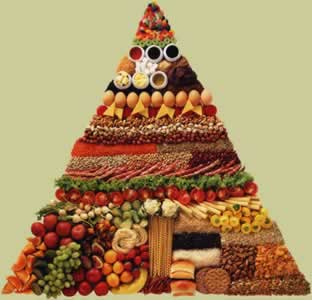 Carbohydrates, in chemical terms, contain carbon (carbo), and also oxygen and hydrogen in the same quantities as water (hydrate). Carbohydrates are found in breads, fruits, vegetables, milk, and grains, and are used to fuel the body through their high energy source. There are 4kcalories contain in each gram of carbohydrate. Protein contains 4kcalories per gram, and fat 9kcalories per gram.
Carbohydrates, in chemical terms, contain carbon (carbo), and also oxygen and hydrogen in the same quantities as water (hydrate). Carbohydrates are found in breads, fruits, vegetables, milk, and grains, and are used to fuel the body through their high energy source. There are 4kcalories contain in each gram of carbohydrate. Protein contains 4kcalories per gram, and fat 9kcalories per gram.
Simple carbohydrates are contained naturally in fresh fruit, vegetables, and milk. On the other hand, other simple carbohydrates are sugars, which are added to food. These added sugars go through a refining process, which separates them from their original plant source, e.g. sugar beets. Because they have been stripped of their nutritional value, foods which contain refined sugars, other than natural sugars found in fruit etc, are known as empty calories. Fruits contain natural sugars, but these also add fiber, vitamins and minerals to the body and control the blood sugar levels. They also contain phytochemicals, which offer the body many health benefits and help to prevent diseases.
Complex carbohydrates are known as the fiber and starch rich foods. Starch links together sugar molecules, and fiber utilizes substances, of which many are carbohydrates but are difficult to digest by the enzymes contained in the stomach and small intestine. Grains are surrounded by bran, which contains six layers of protective fibers. Bran also contains good sources of each of the B vitamins. The lower levels of grain contain the germ, where sprouting occurs. Corn or safflower oil stem from the germ, and contain good levels of vitamin E. Together, the bran and germ contain vitamins, minerals, and fiber in the grain. The remainder of the grain is known as the endosperm, a starchy food supply supplied for a spouting embryo. The endosperm contains starch but also vitamins, minerals, and proteins.
Wholegrain flour contains the endosperm, bran, and germ, as none of the components have been removed. White flour is extracted from the endosperm only, so therefore lacks fiber from the bran and vitamins from the germ. White flour is usually enriched, which returns some of the nutrients lost during processing, but no fiber is returned.
Vegetables and legumes are good sources of starch and fiber. Brocolli and green beans contain less starch than other vegetables, but also high in fiber. Potatoes with skins on contain fiber and vitamins, skins off only starch. Kidney beans contain both fiber and starch, and also contain protein.
Carbohydrates have importance in the body as they are the major source of energy and fuel the cells of the body with glucose. On absorption, monosaccharides enter into the liver through the hepatic portal vein, where galactose and fructose converts into glucose. This circulates throughout the blood and feeds the cells of the body.
Other than energy production, carbohydrates have other functions in the body. Galactose is a molecule which has importance in nerve tissue. Lactose is formed from a combination of glucose and galactose, which is important in breast milk production.
Other important monosaccharides are ribose and deoxyribose, components of RNA (ribonucleic acid) and DNA. They are both synthesised in the body but are not found in adequate quantities through the diet. Oligosaccharides found in beans cannot be digested by the stomach, so remain undigested in the large intestine. They can cause gas when bacteria finally starts to digest them, but they are important to the body. They attach to fats and proteins on the surface cells, and supply cells with vital information. Fiber is important as it cannot be digested by the enzymes of the stomach, so does not absorb, but it is important for the functioning of the gastrointestinal tract. Fiber helps to maintain the healthy functioning of the bowel. Pectin, contained in the skin of fruits and vegetables are known as soluble fibres, which can hold a lot of water. This is why fruits and vegetables keep the body feeling fuller than other starch rich foods. Wheat bran is an insoluble fibre, and together with soluble fibres increases the volume of material held in the intestine. This helps to promote a healthy functioning of the bowel through the stimulation of peristalsis, which causes the colon muscles to work harder, function better, and become stronger.
Glucose absorption takes place in the body after a meal is eaten and causes blood sugar levels to rise. But how quickly the levels rise after eating is referred to the glycemic index, the dietary composition of the foods. Those foods which have a high glycemic index leave the stomach rapidly, whereas foods which stay longer in the stomach, those high in fibre for instance, cause longer, slower rises in blood sugar levels. Blood sugar levels can rise and fall just as rapidly, but signals from the pancreas work to increase or decrease the levels, respectively.
A rise in blood sugar alerts the pancreas to release insulin, a hormone which allows for glucose to transport to various cells of the body. Through the liver, insulin promotes fat storage in limiting quantities, and glucose as glycogen.
